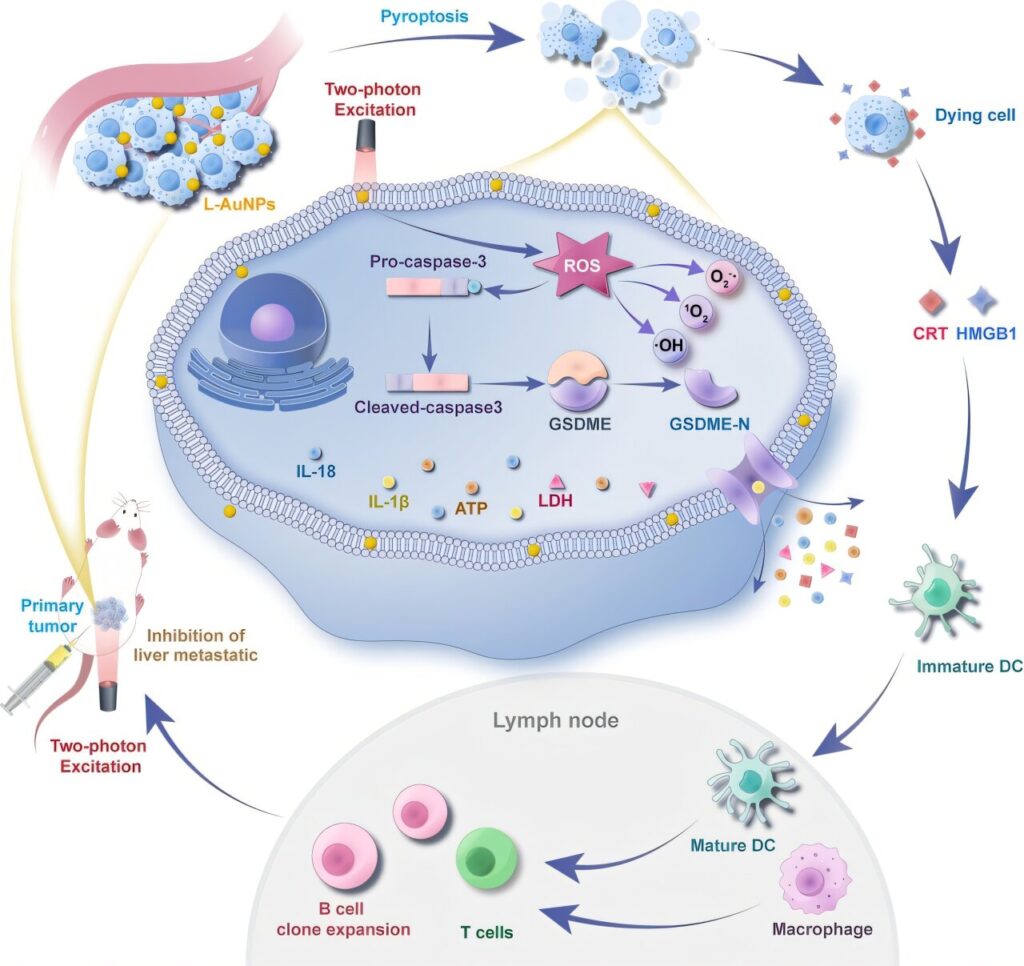Luminescent gold nanoparticles (L-AuNPs) represent a novel class of luminescent nanomaterials that have attracted considerable attention in recent years. They possess a range of exceptional physicochemical properties and are being explored for a diverse array of potential biological applications.
Based on the development of efficient photochemical synthesis strategies, a research group has designed and constructed a new type of two-photon photodynamic therapy (TP-PDT) photosensitizer based on cell membrane targeting of L-AuNPs.
The team was led by Jiang Yuqiang at the Institute of Genetics and Developmental Biology (IGDB) of the Chinese Academy of Sciences (CAS), in collaboration with Peking University, the First Affiliated Hospital of Naval Military Medical University (Shanghai Changhai Hospital) and Renmin University of China. The paper is published in Advanced Composites and Hybrid Materials.
The photosensitizer was demonstrated to be effective in the in situ treatment of colorectal cancer through the induction of pyroptosis and immunogenic cell death (ICD), resulting in the inhibition of liver metastasis and tumor recurrence. This provides a safe and effective new strategy for the treatment of solid tumors.
Tumor recurrence and metastasis are the leading causes of mortality in cancer patients, with approximately 90% of patients ultimately succumbing to these complications. The key challenges to completing treatment are the acidity and immunosuppression present in the tumor microenvironment.
To overcome this problem, it is necessary to lift immunosuppression and stimulate systemic anti-tumor immune responses. However, the multifaceted nature of anti-tumor immunity, involving processes such as antigen release, presentation and immune activation, renders a single treatment approach ineffective.
Photodynamic therapy (PDT) uses photosensitizers to generate reactive oxygen species (ROS) through laser irradiation, which results in the destruction of cancer cells. Recent studies have shown that PDT mediated by specially designed photosensitizers can induce cellular pyrolysis and significantly enhance the anti-tumor immune effect.
In this work, the research team developed a facile photochemical synthesis method for the preparation of luminescent gold nanoparticles (L-AuNP@TMT) coated with 5-mercapto-1,3,4-thiadiazole-2-thioacetic acid (TMT) on the surface. The probe was shown to have remarkable cell membrane targeting ability and remarkable photodynamic therapeutic efficacy.
Under near-infrared two-photon laser irradiation, L-AuNP@TMT is able to efficiently generate ROS, including O2·– and 1O2, which effectively eliminate a variety of cancer cells, including hepatocellular carcinoma and colorectal cancer.
In vivo animal experiments demonstrated that L-AuNP@TMT induced ICD and caspase-3/GSDME-mediated cellular pyroptosis in tumor cells under near-infrared irradiation, thereby activating the body’s anti-tumor immune response and achieving effective tumor suppression in a mouse colorectal cancer model.
A single treatment resulted in a complete disappearance of the tumor in 63% of cases, and no recurrence was observed during the follow-up period of up to six months, indicating a significant immune memory effect.
Furthermore, L-AuNP@TMT was predominantly metabolized and excreted in the urine, with no discernible toxic side effects, thereby demonstrating favorable biosafety.
The developed novel gold nanosystem not only possesses highly efficient photodynamic therapeutic performance, but also activates the host immune system through pyroptosis and immunogenic cell death, thereby establishing a long-term immune memory. This is expected to provide a solution to the challenges of solid tumor treatment and recurrence.


